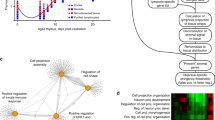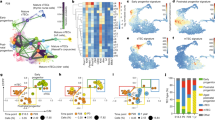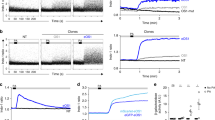Abstract
The three-dimensional thymic microenvironment and calcium signaling pathways are essential for driving positive selection of developing T cells. However, the nature of calcium signals and the diversity of their effects in the thymus are unknown. We describe here a thymic slice preparation for visualizing thymocyte motility and signaling in real time with two-photon microscopy. Naive thymocytes were highly motile at low intracellular calcium concentrations, but during positive selection cells became immobile and showed sustained calcium concentration oscillations. Increased intracellular calcium was necessary and sufficient to arrest thymocyte motility. The calcium dependence of motility acts to prolong thymocyte interactions with antigen-bearing stromal cells, promoting sustained signaling that may enhance the expression of genes underlying positive selection.
This is a preview of subscription content, access via your institution
Access options
Subscribe to this journal
Receive 12 print issues and online access
$209.00 per year
only $17.42 per issue
Buy this article
- Purchase on Springer Link
- Instant access to full article PDF
Prices may be subject to local taxes which are calculated during checkout





Similar content being viewed by others
References
Huesmann, M., Scott, B., Kisielow, P. & von Boehmer, H. Kinetics and efficacy of positive selection in the thymus of normal and T cell receptor transgenic mice. Cell 66, 533–540 (1991).
Shortman, K., Vremec, D. & Egerton, M. The kinetics of T cell antigen receptor expression by subgroups of CD4+8+ thymocytes: delineation of CD4+8+32+ thymocytes as post-selection intermediates leading to mature T cells. J. Exp. Med. 173, 323–332 (1991).
Petrie, H.T. Role of thymic organ structure and stromal composition in steady-state postnatal T-cell production. Immunol. Rev. 189, 8–19 (2002).
Starr, T.K., Jameson, S.C. & Hogquist, K.A. Positive and negative selection of T cells. Annu. Rev. Immunol. 21, 139–176 (2003).
Lewis, R.S. Calcium signaling mechanisms in T lymphocytes. Annu. Rev. Immunol. 19, 497–521 (2001).
Finkel, T.H., McDuffie, M., Kappler, J.W., Marrack, P. & Cambier, J.C. Both immature and mature T cells mobilize Ca2+ in response to antigen receptor crosslinking. Nature 330, 179–181 (1987).
Neilson, J.R., Winslow, M.M., Hur, E.M. & Crabtree, G.R. Calcineurin B1 is essential for positive but not negative selection during thymocyte development. Immunity 20, 255–266 (2004).
Hayden-Martinez, K., Kane, L.P. & Hedrick, S.M. Effects of a constitutively active form of calcineurin on T cell activation and thymic selection. J. Immunol. 165, 3713–3721 (2000).
Raman, V. et al. Requirement for Ca2+/calmodulin-dependent kinase type IV/Gr in setting the thymocyte selection threshold. J. Immunol. 167, 6270–6278 (2001).
Dolmetsch, R.E., Lewis, R.S., Goodnow, C.C. & Healy, J.I. Differential activation of transcription factors induced by Ca2+ response amplitude and duration. Nature 386, 855–858 (1997).
Dolmetsch, R.E., Xu, K. & Lewis, R.S. Calcium oscillations increase the efficiency and specificity of gene expression. Nature 392, 933–936 (1998).
Anderson, G., Moore, N.C., Owen, J.J. & Jenkinson, E.J. Cellular interactions in thymocyte development. Annu. Rev. Immunol. 14, 73–99 (1996).
Nakayama, T. et al. In vivo calcium elevations in thymocytes with T cell receptors that are specific for self ligands. Science 257, 96–99 (1992).
Mariathasan, S., Bachmann, M.F., Bouchard, D., Ohteki, T. & Ohashi, P.S. Degree of TCR internalization and Ca2+ flux correlates with thymocyte selection. J. Immunol. 161, 6030–6037 (1998).
Freedman, B.D., Liu, Q.H., Somersan, S., Kotlikoff, M.I. & Punt, J.A. Receptor avidity and costimulation specify the intracellular Ca2+ signaling pattern in CD4+CD8+ thymocytes. J. Exp. Med. 190, 943–952 (1999).
Haston, W.S., Shields, J.M. & Wilkinson, P.C. Lymphocyte locomotion and attachment on two-dimensional surfaces and in three-dimensional matrices. J. Cell Biol. 92, 747–752 (1982).
Bousso, P., Bhakta, N.R., Lewis, R.S. & Robey, E. Dynamics of thymocyte-stromal cell interactions visualized by two-photon microscopy. Science 296, 1876–1880 (2002).
Miller, M.J., Wei, S.H., Cahalan, M.D. & Parker, I. Autonomous T cell trafficking examined in vivo with intravital two-photon microscopy. Proc. Natl. Acad. Sci. USA 100, 2604–2609 (2003).
Mempel, T.R., Henrickson, S.E. & Von Andrian, U.H. T-cell priming by dendritic cells in lymph nodes occurs in three distinct phases. Nature 427, 154–159 (2004).
Jenkinson, E.J., Van Ewijk, W. & Owen, J.J. Major histocompatibility complex antigen expression on the epithelium of the developing thymus in normal and nude mice. J. Exp. Med. 153, 280–292 (1981).
Seder, R.A., Paul, W.E., Davis, M.M. & Fazekas de St Groth, B. The presence of interleukin 4 during in vitro priming determines the lymphokine-producing potential of CD4+ T cells from T cell receptor transgenic mice. J. Exp. Med. 176, 1091–1098 (1992).
Hare, K.J., Jenkinson, E.J. & Anderson, G. CD69 expression discriminates MHC-dependent and -independent stages of thymocyte positive selection. J. Immunol. 162, 3978–3983 (1999).
Merkenschlager, M. et al. How many thymocytes audition for selection? J. Exp. Med. 186, 1149–1158 (1997).
Yamashita, I., Nagata, T., Tada, T. & Nakayama, T. CD69 cell surface expression identifies developing thymocytes which audition for T cell antigen receptor-mediated positive selection. Int. Immunol. 5, 1139–1150 (1993).
Revy, P., Sospedra, M., Barbour, B. & Trautmann, A. Functional antigen-independent synapses formed between T cells and dendritic cells. Nat. Immunol. 2, 925–931 (2001).
Negulescu, P.A., Krasieva, T.B., Khan, A., Kerschbaum, H.H. & Cahalan, M.D. Polarity of T cell shape, motility, and sensitivity to antigen. Immunity 4, 421–430 (1996).
Dustin, M.L., Bromley, S.K., Kan, Z., Peterson, D.A. & Unanue, E.R. Antigen receptor engagement delivers a stop signal to migrating T lymphocytes. Proc. Natl. Acad. Sci. USA 94, 3909–3913 (1997).
Stewart, M.P., Cabanas, C. & Hogg, N. T cell adhesion to intercellular adhesion molecule-1 (ICAM-1) is controlled by cell spreading and the activation of integrin LFA-1. J. Immunol. 156, 1810–1817 (1996).
Petrie, H.T. Cell migration and the control of post-natal T-cell lymphopoiesis in the thymus. Nat. Rev. Immunol. 3, 859–866 (2003).
Campbell, J.J., Pan, J. & Butcher, E.C. Cutting edge: developmental switches in chemokine responses during T cell maturation. J. Immunol. 163, 2353–2357 (1999).
Uehara, S., Song, K., Farber, J.M. & Love, P.E. Characterization of CCR9 expression and CCL25/thymus-expressed chemokine responsiveness during T cell development: CD3highCD69+ thymocytes and γδTCR+ thymocytes preferentially respond to CCL25. J. Immunol. 168, 134–142 (2002).
Ueno, T. et al. CCR7 signals are essential for cortex-medulla migration of developing thymocytes. J. Exp. Med. 200, 493–505 (2004).
Adachi, S., Amasaki, Y., Miyatake, S., Arai, N. & Iwata, M. Successive expression and activation of NFAT family members during thymocyte differentiation. J. Biol. Chem. 275, 14708–14716 (2000).
Amasaki, Y., Masuda, E.S., Imamura, R., Arai, K. & Arai, N. Distinct NFAT family proteins are involved in the nuclear NFAT-DNA binding complexes from human thymocyte subsets. J. Immunol. 160, 2324–2333 (1998).
Oukka, M. et al. The transcription factor NFAT4 is involved in the generation and survival of T cells. Immunity 9, 295–304 (1998).
Amasaki, Y. et al. A constitutively nuclear form of NFATx shows efficient transactivation activity and induces differentiation of CD4+CD8+ T cells. J. Biol. Chem. 277, 25640–25648 (2002).
Tomida, T., Hirose, K., Takizawa, A., Shibasaki, F. & Iino, M. NFAT functions as a working memory of Ca2+ signals in decoding Ca2+ oscillation. EMBO J. 22, 3825–3832 (2003).
Donnadieu, E., Bismuth, G. & Trautmann, A. Antigen recognition by helper T cells elicits a sequence of distinct changes of their shape and intracellular calcium. Curr. Biol. 4, 584–595 (1994).
Dustin, M.L. Stop and go traffic to tune T cell responses. Immunity 21, 305–314 (2004).
Jacobelli, J., Chmura, S.A., Buxton, D.B., Davis, M.M. & Krummel, M.F. A single class II myosin modulates T cell motility and stopping, but not synapse formation. Nat. Immunol. 5, 531–538 (2004).
Buxton, D.B. & Adelstein, R.S. Calcium-dependent threonine phosphorylation of nonmuscle myosin in stimulated RBL-2H3 mast cells. J. Biol. Chem. 275, 34772–34779 (2000).
Stewart, M.P., McDowall, A. & Hogg, N. LFA-1-mediated adhesion is regulated by cytoskeletal restraint and by a Ca2+-dependent protease, calpain. J. Cell Biol. 140, 699–707 (1998).
Merkenschlager, M., Benoist, C. & Mathis, D. Evidence for a single-niche model of positive selection. Proc. Natl. Acad. Sci. USA 91, 11694–11698 (1994).
Merkenschlager, M. Tracing interactions of thymocytes with individual stromal cell partners. Eur. J. Immunol. 26, 892–896 (1996).
Yasutomo, K., Lucas, B. & Germain, R.N. TCR signaling for initiation and completion of thymocyte positive selection has distinct requirements for ligand quality and presenting cell type. J. Immunol. 165, 3015–3022 (2000).
Miller, M.J., Hejazi, A.S., Wei, S.H., Cahalan, M.D. & Parker, I. T cell repertoire scanning is promoted by dynamic dendritic cell behavior and random T cell motility in the lymph node. Proc. Natl. Acad. Sci. USA 101, 998–1003 (2004).
Adachi, S. & Iwata, M. Duration of calcineurin and Erk signals regulates CD4/CD8 lineage commitment of thymocytes. Cell. Immunol. 215, 45–53 (2002).
Yasutomo, K., Doyle, C., Miele, L., Fuchs, C. & Germain, R.N. The duration of antigen receptor signalling determines CD4+ versus CD8+ T-cell lineage fate. Nature 404, 506–510 (2000).
Grynkiewicz, G., Poenie, M. & Tsien, R.Y. A new generation of Ca2+ indicators with greatly improved fluorescence properties. J. Biol. Chem. 260, 3440–3450 (1985).
Acknowledgements
We thank M. Davis and M. Prakriya for comments on the manuscript; D. Madison for use of the Vibratome and advice on culturing slices; S. Smith and N. O'Rourke for help in designing and constructing the two-photon microscope; V. Li for assistance with immunohistochemistry; and V. Sohal and members of the Lewis lab for stimulating discussion. Supported by the Medical Scientist Training Program at Stanford (N.R.B. and D.Y.O.) and by US National Institutes of Health (R01 GM45374) and the Mathers Foundation (R.S.L.).
Author information
Authors and Affiliations
Corresponding author
Ethics declarations
Competing interests
The authors declare no competing financial interests.
Supplementary information
Supplementary Fig. 1
Surface phenotype of 5C.C7 thymocytes from B6 mice (PDF 82 kb)
Supplementary Fig. 2
Reticular structure of stromal cells in thymic slices. (PDF 233 kb)
Supplementary Fig. 3
Additional examples of Ca2+ signals representative of cells in B10.BR slices (positive selection conditions). (PDF 89 kb)
Supplementary Fig. 4
Characterization of Ca2+ oscillations and motility in thymocytes under positive selection conditions. (PDF 85 kb)
Supplementary Fig. 5
Long-term tracking of a single cell under positive selection conditions. (PDF 126 kb)
Supplementary Fig. 6
Cells undergoing Ca2+ oscillations during positive selection undergo significant displacement only after [Ca2+]i falls. (PDF 26 kb)
Supplementary Video 1
FITC-stained slice showing the packing density and motility of endogenous cells. This C57BL/6 slice was stained with 400 μg/ml FITC in PBS plus 5% FBS for 6 min and subsequently put on the microscope stage for perfusion and imaging. An excitation wavelength of 870 nm was used and emission at 535 nm was collected from a plane 40 μm in from the cut surface. Frames were collected every 10 s for a total of 15 min. Note the movement of brightly stained stromal cell processes as thymocytes migrate through the tissue. Frame rate: 10 fps (100x time compression). Scale bar = 10 μm. (MOV 3863 kb)
Supplementary Video 2
Z series through an FM4-64 labeled slice (red) reseeded with calcein-AM-loaded thymocytes (green). Thymocytes were labeled with 1 μM calcein-AM (Molecular Probes) for 30 min at room temperature and allowed to migrate into slices for 3 hr. Slices were then stained with 10 μM FM4-64 (Molecular Probes) for 20 min at room temperature. 870 nm excitation was used, and emission was collected through 535 bandpass and 580 LP filters. Sections are 2 μm apart starting at the cut surface and ending 70 μm into the slice. Scale bar = 10 μm. (MOV 2211 kb)
Supplementary Video 3
Motility of thymocytes in a non-selecting environment. 5C.C7 thymocytes from a B6 mouse were loaded with indo-PE3 and allowed to migrate into a B10 slice. 4 images at 5-μm intervals spanning a distance of 15-30 μm into the slice were collected every 35 s for a total of 42 min. For each time point of the movie, each image plane (675SP emission image) was encoded with a different color (red, green, blue, gray from superficial to deep), and superimposed. The capsule is seen near the top. Frame rate: 10 fps (350x time compression). Scale bar = 10 μm. (MOV 2665 kb)
Supplementary Video 4
[Ca2+]i and motility of 5C.C7/B6 thymocytes in a B6 slice (non-selecting conditions). Frames were collected every 10 s for 19 min. For Videos 4-7, the 675SP/390 indo-PE3 emission ratio is displayed using a rainbow spectrum lookup table ranging from blue (low [Ca2+]i) to red (high [Ca2+]i). In this video, blue corresponds to [Ca2+]i ≅ 75, yellow to 700, and red to 3000 nM. Frame rate: 8 fps (80x time compression). Scale bar = 10 μm. (MOV 728 kb)
Supplementary Video 5
[Ca2+]i and motility of 5C.C7/B6 thymocytes in a B10.BR slice (positively selecting conditions). Blue corresponds to [Ca2+]i ≅ 75, yellow to 700, and red to 3000 nM. Frames were collected every 10 s for 62 min. Frame rate: 8 fps (80x time compression). Scale bar = 10 μm. (MOV 2970 kb)
Supplementary Video 6
Elevation of [Ca2+]i reversibly immobilizes thymocytes in the thymic slice. The movie shows the indo-PE3 emission ratio of 5C.C7/B6 thymocytes in a B10.BR slice pretreated with thapsigargin (see Methods). The bath solution was changed from 1.25 mM Ca2+ to 0 Ca2+ and back to 1.25 mM Ca2+ as indicated. Blue corresponds to [Ca2+]i ≅ 250 and yellow to 2000 nM. Frames were collected every 10 s for 53 min. Frame rate: 30 fps (300x time compression). Scale bar = 10 μm. (MOV 796 kb)
Supplementary Video 7
High extracellular [K+] reduces [Ca2+]i and relieves motility arrest. This movie shows B6 thymocytes in a B6 slice pretreated with thapsigargin as in Movie 8. The bath solution is changed from 5 to 132 mM K+ in the constant presence of 0.4 mM Ca2+. Blue corresponds to [Ca2+]i ≅ 250, yellow to 1500 nM. Frames were collected every 20 s for 29 min. Frame rate: 15 fps (300x time compression). Scale bar = 10 μm. (MOV 293 kb)
Supplementary Video 8
Effect of terminating Ca2+ oscillations on cell motility. 5C.C7/B6 thymocytes loaded with indo-PE3 were imaged in a B10.BR (positively selecting) slice. 4 images at 7-μm intervals spanning a distance of 13-34 μm into the slice were collected every 38 s for a total of 41 min. Cell depth is displayed as described for Supplementary Video 3. A stationary cell undergoing Ca2+ oscillations is marked by a white square at its center (cell shown in Fig. 5 in the main text). A 10-μm-radius white circle is centered on the cell's starting position. After the bath solution is changed from 1.25 mM Ca2+ to 0 Ca2+, the cell becomes motile and leaves the circle. Frame rate: 8 fps (304x time compression). Scale bar = 10 μm. (MOV 1050 kb)
Rights and permissions
About this article
Cite this article
Bhakta, N., Oh, D. & Lewis, R. Calcium oscillations regulate thymocyte motility during positive selection in the three-dimensional thymic environment. Nat Immunol 6, 143–151 (2005). https://doi.org/10.1038/ni1161
Received:
Accepted:
Published:
Issue Date:
DOI: https://doi.org/10.1038/ni1161
This article is cited by
-
Specialized transendothelial dendritic cells mediate thymic T-cell selection against blood-borne macromolecules
Nature Communications (2021)
-
Factors that influence the thymic selection of CD8αα intraepithelial lymphocytes
Mucosal Immunology (2021)
-
Optogenetic manipulation of calcium signals in single T cells in vivo
Nature Communications (2020)
-
Calcium signaling: breast cancer’s approach to manipulation of cellular circuitry
Biophysical Reviews (2020)
-
Live-cell imaging reveals the relative contributions of antigen-presenting cell subsets to thymic central tolerance
Nature Communications (2019)



